5-Benzothiazolamine
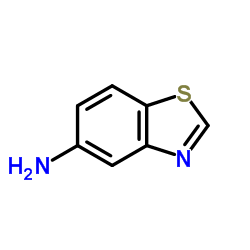
5-Benzothiazolamine structure
|
Common Name | 5-Benzothiazolamine | ||
|---|---|---|---|---|
| CAS Number | 1123-93-9 | Molecular Weight | 150.201 | |
| Density | 1.4±0.1 g/cm3 | Boiling Point | 323.1±15.0 °C at 760 mmHg | |
| Molecular Formula | C7H6N2S | Melting Point | 55ºC | |
| MSDS | USA | Flash Point | 149.2±20.4 °C | |
| Name | 1,3-benzothiazol-5-amine |
|---|---|
| Synonym | More Synonyms |
| Density | 1.4±0.1 g/cm3 |
|---|---|
| Boiling Point | 323.1±15.0 °C at 760 mmHg |
| Melting Point | 55ºC |
| Molecular Formula | C7H6N2S |
| Molecular Weight | 150.201 |
| Flash Point | 149.2±20.4 °C |
| Exact Mass | 150.025162 |
| PSA | 67.15000 |
| LogP | 0.73 |
| Vapour Pressure | 0.0±0.7 mmHg at 25°C |
| Index of Refraction | 1.763 |
Synonym:None Known Section 2 - COMPOSITION, INFORMATION ON INGREDIENTS
Risk Phrases: 36/37/38 Section 3 - HAZARDS IDENTIFICATION EMERGENCY OVERVIEW
Irritating to eyes, respiratory system and skin. Potential Health Effects Eye: Causes eye irritation. May cause chemical conjunctivitis. Skin: Causes skin irritation. May be harmful if absorbed through the skin. Ingestion: May cause gastrointestinal irritation with nausea, vomiting and diarrhea. May be harmful if swallowed. Inhalation: Causes respiratory tract irritation. May be harmful if inhaled. Chronic: No information found. Section 4 - FIRST AID MEASURES Eyes: Immediately flush eyes with plenty of water for at least 15 minutes, occasionally lifting the upper and lower eyelids. Get medical aid. Skin: Get medical aid. Flush skin with plenty of water for at least 15 minutes while removing contaminated clothing and shoes. Wash clothing before reuse. Ingestion: Never give anything by mouth to an unconscious person. Get medical aid. Do NOT induce vomiting. If conscious and alert, rinse mouth and drink 2-4 cupfuls of milk or water. Inhalation: Remove from exposure and move to fresh air immediately. If not breathing, give artificial respiration. If breathing is difficult, give oxygen. Get medical aid. Notes to Physician: Treat symptomatically and supportively. Section 5 - FIRE FIGHTING MEASURES General Information: As in any fire, wear a self-contained breathing apparatus in pressure-demand, MSHA/NIOSH (approved or equivalent), and full protective gear. During a fire, irritating and highly toxic gases may be generated by thermal decomposition or combustion. Extinguishing Media: Use water spray, dry chemical, carbon dioxide, or appropriate foam. Section 6 - ACCIDENTAL RELEASE MEASURES General Information: Use proper personal protective equipment as indicated in Section 8. Spills/Leaks: Clean up spills immediately, observing precautions in the Protective Equipment section. Sweep up or absorb material, then place into a suitable clean, dry, closed container for disposal. Avoid generating dusty conditions. Provide ventilation. Section 7 - HANDLING and STORAGE Handling: Minimize dust generation and accumulation. Avoid contact with eyes, skin, and clothing. Keep container tightly closed. Avoid ingestion and inhalation. Wash clothing before reuse. Storage: Store in a tightly closed container. Store in a cool, dry, well-ventilated area away from incompatible substances. Section 8 - EXPOSURE CONTROLS, PERSONAL PROTECTION Engineering Controls: Facilities storing or utilizing this material should be equipped with an eyewash facility and a safety shower. Use adequate ventilation to keep airborne concentrations low. Exposure Limits CAS# 1123-93-9: Personal Protective Equipment Eyes: Wear appropriate protective eyeglasses or chemical safety goggles as described by OSHA's eye and face protection regulations in 29 CFR 1910.133 or European Standard EN166. Skin: Wear appropriate protective gloves to prevent skin exposure. Clothing: Wear appropriate protective clothing to prevent skin exposure. Respirators: A respiratory protection program that meets OSHA's 29 CFR 1910.134 and ANSI Z88.2 requirements or European Standard EN 149 must be followed whenever workplace conditions warrant respirator use. Section 9 - PHYSICAL AND CHEMICAL PROPERTIES Physical State: Solid Color: off-white Odor: Not available. pH: Not available. Vapor Pressure: Not available. Viscosity: Not available. Boiling Point: Not available. Freezing/Melting Point: 58-61 deg C Autoignition Temperature: Not available. Flash Point: Not available. Explosion Limits, lower: Not available. Explosion Limits, upper: Not available. Decomposition Temperature: Solubility in water: Specific Gravity/Density: Molecular Formula: C7H6N2S Molecular Weight: 150.20 Section 10 - STABILITY AND REACTIVITY Chemical Stability: Stable at room temperature in closed containers under normal storage and handling conditions. Conditions to Avoid: Dust generation. Incompatibilities with Other Materials: Oxidizing agents, acids, acid chlorides. Hazardous Decomposition Products: Carbon monoxide, oxides of nitrogen, oxides of sulfur, carbon dioxide. Hazardous Polymerization: Will not occur. Section 11 - TOXICOLOGICAL INFORMATION RTECS#: CAS# 1123-93-9 unlisted. LD50/LC50: Not available. Carcinogenicity: 1,3-Benzothiazol-5-amine - Not listed by ACGIH, IARC, or NTP. Section 12 - ECOLOGICAL INFORMATION Section 13 - DISPOSAL CONSIDERATIONS Dispose of in a manner consistent with federal, state, and local regulations. Section 14 - TRANSPORT INFORMATION IATA Shipping Name: Not regulated. Hazard Class: UN Number: Packing Group: IMO Shipping Name: Not regulated. Hazard Class: UN Number: Packing Group: RID/ADR Shipping Name: Not regulated. Hazard Class: UN Number: Packing group: Section 15 - REGULATORY INFORMATION European/International Regulations European Labeling in Accordance with EC Directives Hazard Symbols: XI Risk Phrases: R 36/37/38 Irritating to eyes, respiratory system and skin. Safety Phrases: S 22 Do not breathe dust. S 26 In case of contact with eyes, rinse immediately with plenty of water and seek medical advice. S 36/37/39 Wear suitable protective clothing, gloves and eye/face protection. WGK (Water Danger/Protection) CAS# 1123-93-9: No information available. Canada None of the chemicals in this product are listed on the DSL/NDSL list. CAS# 1123-93-9 is not listed on Canada's Ingredient Disclosure List. US FEDERAL TSCA CAS# 1123-93-9 is not listed on the TSCA inventory. It is for research and development use only. SECTION 16 - ADDITIONAL INFORMATION N/A |
| Hazard Codes | T+ |
|---|---|
| Risk Phrases | R20/21/22 |
| Safety Phrases | 22-26-36/37/39 |
| RIDADR | UN 2811 |
| HS Code | 2934999090 |
|
~52% 
5-Benzothiazolamine CAS#:1123-93-9 |
| Literature: WO2005/28445 A2, ; Page/Page column 28 ; WO 2005/028445 A2 |
|
~% 
5-Benzothiazolamine CAS#:1123-93-9 |
| Literature: Phytochemistry, , vol. 74, p. 159 - 165 |
|
~% 
5-Benzothiazolamine CAS#:1123-93-9 |
| Literature: Phytochemistry, , vol. 74, p. 159 - 165 |
|
~% 
5-Benzothiazolamine CAS#:1123-93-9 |
| Literature: Chemistry of Heterocyclic Compounds (New York, NY, United States), , vol. 8, p. 36 - 38 Khimiya Geterotsiklicheskikh Soedinenii, , vol. 8, # 1 p. 38 - 40 |
|
~% 
5-Benzothiazolamine CAS#:1123-93-9 |
| Literature: Helvetica Chimica Acta, , vol. 33, p. 1429,1431 |
|
~% 
5-Benzothiazolamine CAS#:1123-93-9 |
| Literature: Helvetica Chimica Acta, , vol. 33, p. 1429,1431 |
| Precursor 6 | |
|---|---|
| DownStream 7 | |
| HS Code | 2934999090 |
|---|---|
| Summary | 2934999090. other heterocyclic compounds. VAT:17.0%. Tax rebate rate:13.0%. . MFN tariff:6.5%. General tariff:20.0% |
| benzo[d]thiazol-5-amine |
| Benzothiazol-5-ylamine |
| 5-AMINOBENZOTHIAZOLE |
| 5-Amino-1,3-benzothiazole |
| benzothiazol-5-amine |
| Benzothiazol-5-ylamin |
| 1,3-Benzothiazol-5-amine |
| 1,3-benzothiazol-5-ylamine |
| MFCD04115282 |
| 5-Benzothiazolamine |
| 1,3-Benzothiazole-5-amine |
| EINECS 214-381-8 |
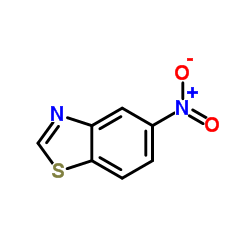
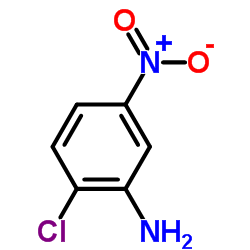
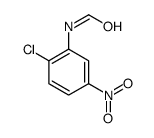


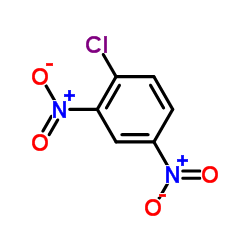
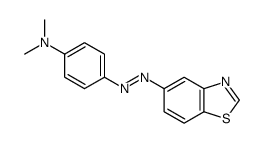 CAS#:18463-90-6
CAS#:18463-90-6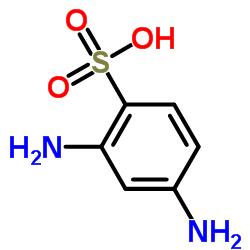 CAS#:88-63-1
CAS#:88-63-1![Benzo[d]thiazole-5-carbonitrile structure](https://image.chemsrc.com/caspic/265/58249-57-3.png) CAS#:58249-57-3
CAS#:58249-57-3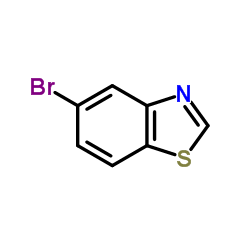 CAS#:768-11-6
CAS#:768-11-6![4-Bromobenzo[d]thiazol-5-amine structure](https://image.chemsrc.com/caspic/173/769-19-7.png) CAS#:769-19-7
CAS#:769-19-7 CAS#:36894-61-8
CAS#:36894-61-8![BENZO[D]THIAZOLE-2,5-DIAMINE structure](https://image.chemsrc.com/caspic/070/50480-29-0.png) CAS#:50480-29-0
CAS#:50480-29-0
